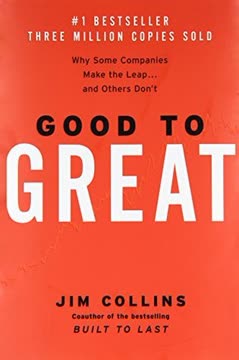Key Takeaways
1. Set Clear and Concise One Minute Goals
"One Minute Goal Setting is simply: 1. Agree on your goals. 2. See what good behavior looks like. 3. Write out each of your goals on a single sheet of paper using less than 250 words."
Clarity is key. One Minute Goals are the foundation of effective management. They provide clear direction and expectations for employees. By setting concise, measurable goals, managers ensure that everyone understands what is expected of them.
Simplicity enhances effectiveness. Goals should be:
- Written on a single page
- Less than 250 words
- Easily read in one minute
- Focused on key responsibilities (3-6 goals)
This approach eliminates confusion and allows for frequent review, keeping goals at the forefront of daily activities.
2. Catch People Doing Something Right: One Minute Praisings
"Help People Reach Their Full Potential Catch Them Doing Something Right"
Positive reinforcement works. One Minute Praisings are powerful tools for motivating employees and reinforcing desired behaviors. By actively looking for opportunities to praise, managers create a positive work environment and boost morale.
Key elements of effective praisings:
- Immediate and specific feedback
- Genuine expression of feelings
- Brief pause to let the praise sink in
- Encouragement to continue good performance
This approach helps employees understand what they're doing right and motivates them to repeat those behaviors.
3. Deliver Timely and Specific One Minute Reprimands
"The fact that the feedback is so immediate is an important lesson in why the One Minute Reprimand works so well. Unless discipline occurs as close to the misbehavior as possible, it tends not to be as helpful in influencing future behavior."
Timely correction is crucial. One Minute Reprimands address poor performance promptly and specifically. This immediate feedback helps employees understand what they did wrong and how to improve.
Structure of a One Minute Reprimand:
- Describe the incorrect behavior specifically
- Express how you feel about it
- Pause to let the message sink in
- Reaffirm the person's worth
- Remind them you have confidence in them
By focusing on the behavior, not the person, managers maintain a positive relationship while correcting performance issues.
4. Align Individual Goals with Organizational Objectives
"Effective managers manage themselves and the people they work with so that both the organization and the people profit from their presence."
Synergy drives success. Aligning individual goals with organizational objectives ensures that everyone is working towards the same end. This alignment creates a sense of purpose and helps employees understand how their work contributes to the bigger picture.
Benefits of goal alignment:
- Increased employee engagement
- Improved organizational performance
- Enhanced teamwork and collaboration
- Clearer decision-making at all levels
By helping employees see the connection between their work and the company's success, managers foster a more committed and productive workforce.
5. Provide Immediate and Actionable Feedback
"Feedback is the Breakfast of Champions."
Timely feedback fuels growth. Regular, immediate feedback is essential for continuous improvement. By providing actionable insights promptly, managers help employees adjust their performance in real-time.
Effective feedback should be:
- Specific and behavior-focused
- Balanced between positive and constructive
- Delivered as close to the event as possible
- Followed up with support and resources for improvement
This approach creates a culture of learning and adaptation, where employees are constantly striving to enhance their performance.
6. Balance Praise and Reprimands to Motivate Performance
"I'm a democratic manager." "Participative." "Supportive." "Considerate." "Humanistic."
Effective management requires balance. The One Minute Manager strikes a balance between being supportive and demanding. This approach combines high expectations with high support, creating an environment where employees feel valued and motivated to perform.
Key aspects of balanced management:
- Set clear expectations
- Provide regular positive reinforcement
- Address performance issues promptly
- Maintain a focus on results and relationships
By balancing praise and reprimands, managers create a positive, high-performance culture that brings out the best in their team.
7. Empower Employees to Become Self-Managers
"After awhile you begin to catch yourself doing things right and you start praising yourself."
Self-management drives excellence. The ultimate goal of the One Minute Manager is to develop employees who can manage themselves. By teaching employees to set their own goals, monitor their performance, and self-correct, managers create a more efficient and effective organization.
Steps to foster self-management:
- Teach goal-setting skills
- Encourage self-monitoring of performance
- Promote self-praise and self-correction
- Gradually reduce direct oversight
As employees become more self-reliant, managers can focus on higher-level strategic tasks, benefiting both the individual and the organization.
8. Foster a Culture of Continuous Improvement
"Take a minute: Look at your goals. Look at your performance. See if your behavior matches your goals."
Growth mindset drives success. Creating a culture of continuous improvement ensures that both individuals and the organization are constantly evolving and adapting. By encouraging regular self-reflection and goal adjustment, managers promote ongoing development.
Key practices for continuous improvement:
- Regular goal review and updating
- Encouragement of experimentation and learning from mistakes
- Celebration of progress and incremental improvements
- Provision of resources for skill development
This approach keeps the organization agile and competitive, while also supporting employee growth and job satisfaction.
9. Implement the 80-20 Rule in Goal Setting
"The old man believes in the 80-20 goal-setting rule. That is, 80% of your really important results will come from 20% of your goals."
Focus on high-impact goals. The 80-20 rule, or Pareto Principle, suggests that a small number of goals will have the most significant impact on results. By focusing on these key areas, managers and employees can maximize their effectiveness and efficiency.
Applying the 80-20 rule:
- Identify the most critical goals (usually 3-6)
- Allocate more resources and attention to these goals
- Regularly review and adjust priorities
- Avoid getting bogged down in less impactful tasks
This focused approach helps prevent overwhelm and ensures that effort is directed towards the most important objectives.
10. Recognize the Difference Between Behavior and Worth
"We are not just our behavior. We are the person managing our behavior."
Separate performance from identity. Understanding the distinction between a person's behavior and their inherent worth is crucial for effective management. This perspective allows managers to address performance issues without damaging employees' self-esteem or motivation.
Key principles:
- Focus feedback on specific behaviors, not personal attributes
- Reinforce the value of the individual, even when criticizing performance
- Encourage a growth mindset where mistakes are opportunities for learning
- Foster an environment where people feel safe to take risks and learn
By maintaining this separation, managers can build trust and create an environment where constructive feedback is welcomed and acted upon.
Last updated:
FAQ
What's "The One Minute Manager" about?
- Overview: "The One Minute Manager" by Kenneth H. Blanchard and Spencer Johnson is a concise guide to effective management through three key techniques: One Minute Goals, One Minute Praisings, and One Minute Reprimands.
- Story Format: The book is presented as a story about a young man seeking effective management techniques, which makes it engaging and easy to understand.
- Practical Techniques: It provides practical advice backed by studies in medicine and behavioral sciences, explaining why these methods work well with people.
- Application: By the end of the book, readers learn how to apply these techniques to their own management situations.
Why should I read "The One Minute Manager"?
- Efficiency: The book offers simple, time-efficient management techniques that can lead to significant improvements in productivity and employee satisfaction.
- Proven Success: It has been widely acclaimed and used by various successful organizations, indicating its effectiveness in real-world applications.
- Broad Appeal: The methods are applicable across different industries and roles, making it a valuable read for anyone in a leadership position.
- Personal Development: It not only helps in managing others but also in managing oneself, leading to personal growth and better work-life balance.
What are the key takeaways of "The One Minute Manager"?
- One Minute Goals: Clearly define goals and performance standards in a concise manner to ensure everyone knows what is expected.
- One Minute Praisings: Catch people doing something right and provide immediate, specific praise to reinforce positive behavior.
- One Minute Reprimands: Address mistakes promptly and specifically, focusing on the behavior, not the person, and reaffirm their value afterward.
- Feedback Importance: Regular feedback is crucial for motivation and improvement, as it helps align behavior with goals.
What is the One Minute Goal Setting method?
- Clarity and Simplicity: Goals should be clear and concise, written on a single page with less than 250 words.
- Alignment: Both manager and employee should agree on the goals to ensure mutual understanding and commitment.
- Regular Review: Goals should be reviewed frequently to track progress and make necessary adjustments.
- Focus on Key Areas: Concentrate on the 20% of goals that will yield 80% of the results, avoiding unnecessary complexity.
How does the One Minute Praising work?
- Immediate Feedback: Praise should be given immediately after the desired behavior is observed to reinforce it effectively.
- Specificity: Clearly state what the person did right and how it benefits the organization, making the praise meaningful.
- Emotional Connection: Share how the behavior makes you feel and encourage more of the same, fostering a positive work environment.
- Supportive Touch: If appropriate, a supportive touch can enhance the sincerity and impact of the praise.
What is the One Minute Reprimand technique?
- Timeliness: Address the issue as soon as possible after the mistake is made to ensure the feedback is relevant and impactful.
- Specificity: Clearly describe what the person did wrong and how it affects the organization, focusing on the behavior, not the person.
- Emotional Honesty: Share your feelings about the mistake to convey the seriousness of the issue.
- Reaffirmation: Conclude by reaffirming the person's value and your confidence in their abilities, separating the behavior from their worth.
Why do the techniques in "The One Minute Manager" work?
- Behavioral Science: The methods are grounded in principles of behavioral science, emphasizing the importance of feedback and reinforcement.
- Motivation: They leverage the natural human desire for recognition and clear expectations, which are powerful motivators.
- Efficiency: The techniques are designed to be quick and easy to implement, making them practical for busy managers.
- Balance: They strike a balance between being results-oriented and people-oriented, ensuring both organizational success and employee satisfaction.
What are some of the best quotes from "The One Minute Manager" and what do they mean?
- "People Who Feel Good About Themselves Produce Good Results": This highlights the link between employee morale and productivity, emphasizing the importance of positive reinforcement.
- "Feedback is the Breakfast of Champions": It underscores the critical role of feedback in personal and professional development, suggesting that regular feedback is essential for success.
- "We Are Not Just Our Behavior; We Are The Person Managing Our Behavior": This quote separates a person's worth from their actions, promoting a respectful and constructive approach to management.
How can I apply the One Minute Manager techniques in my workplace?
- Start with Goals: Begin by setting clear, concise goals with your team, ensuring everyone understands their responsibilities and performance standards.
- Practice Praisings: Make it a habit to catch your team members doing something right and provide immediate, specific praise to reinforce positive behaviors.
- Use Reprimands Wisely: When mistakes occur, address them promptly and specifically, focusing on the behavior and not the person, and always end on a positive note.
- Encourage Self-Management: Foster an environment where team members can set their own goals and monitor their performance, promoting autonomy and accountability.
What are the benefits of becoming a One Minute Manager?
- Improved Productivity: By setting clear goals and providing regular feedback, you can enhance both the quality and quantity of work produced by your team.
- Employee Satisfaction: The techniques promote a positive work environment, leading to higher morale and lower turnover rates.
- Time Efficiency: The methods are designed to be quick and easy to implement, allowing you to manage effectively without consuming excessive time.
- Personal Growth: As you practice these techniques, you develop better communication and leadership skills, contributing to your own professional development.
How does "The One Minute Manager" address common management challenges?
- Clarity in Expectations: By setting One Minute Goals, the book addresses the common issue of unclear expectations, ensuring everyone knows what is required.
- Positive Reinforcement: One Minute Praisings help counteract the tendency to focus on negative behaviors, promoting a more positive and motivating work environment.
- Constructive Criticism: The One Minute Reprimand provides a structured way to address mistakes without damaging relationships, maintaining respect and trust.
- Balanced Approach: The book offers a balanced approach to management, combining a focus on results with a genuine concern for people.
What impact has "The One Minute Manager" had on management practices?
- Widespread Adoption: The book has been widely adopted by organizations across various industries, influencing management practices globally.
- Training Programs: Its principles have been incorporated into numerous management training programs, helping to develop effective leaders.
- Cultural Shift: It has contributed to a shift towards more people-oriented management styles, emphasizing the importance of employee well-being.
- Enduring Relevance: Despite being published decades ago, its simple yet effective techniques continue to be relevant and valuable in today's fast-paced work environments.
Review Summary
The One Minute Manager receives mixed reviews, with praise for its simplicity and practical advice on goal-setting, praising, and redirecting employees. Critics appreciate its concise, parable-style presentation of management concepts. However, some find it overly simplistic and repetitive. Positive reviewers highlight its effectiveness in improving workplace dynamics, while detractors argue it lacks depth and relies on manipulative techniques. Despite divided opinions, many readers acknowledge the book's influence and potential benefits for new managers seeking basic leadership guidance.
Similar Books










Download PDF
Download EPUB
.epub digital book format is ideal for reading ebooks on phones, tablets, and e-readers.














